.
A Scene from The Beggar's Opera, Act V: William Hogarth, 1728-1729, oil on canvas, 51 x 61 cm (National Gallery of Art, Washington, D.C.)
Act Three. Scene 13. The Condemn'd Hold
MACHEATH, in a melancholy Posture.
Air LXVII.--Green Sleeves.
Since Laws were made for ev'ry Degree,JAILOR. Some Friends of yours, Captain, desire to be admitted----I leave you together.
To curb Vice in others, as well as me,
I wonder we han't better Company,
Upon Tyburn Tree!
But Gold from Law can take out the Sting;
And if rich Men like us were to swing,
'Twould thin the Land, such Numbers to string
Upon Tyburn Tree!
Scene 14.
MACHEATH, BEN BUDGE, MATT OF THE MINT.
MACHEATH. For my having broke Prison,
you see, Gentlemen, I am order'd immediate Execution.----The Sheriff's
Officers, I believe, are now at the Door.----That Jemmy Twitcher should
peach me, I own surpris'd me!----'Tis a plain Proof that the World is
all alike, and that even our Gang can no more trust one another than
other People. Therefore, I beg you, Gentlemen, look well to yourselves,
for in all probability you may live some Months longer.
MATT. We are heartily sorry, Captain,
for your Misfortune.----But 'tis what we must all come to.
MACHEATH. Peachum and Lockit, you
know, are infamous Scoundrels. Their Lives are as much in your Power,
as yours are in theirs.----
Remember your dying Friend!----'Tis my last Request.----Bring those Villains to the Gallows before you, and I am satisfied.
MATT. We'll do it.
JAILOR. Miss Polly and Miss Lucy
intreat a Word with you.
MACHEATH. Gentlemen, adieu.
Scene 15.
LUCY, MACHEATH, POLLY.
MACHEATH. My dear Lucy----My dear
Polly. Whatsoever hath pass'd between us is now at an end----if you are
fond of marrying again, the best Advice I can give you is to Ship
yourselves to the West-Indies, where you'll have a fair Chance of
getting a Husband a-piece, or by good Luck, two or three, as you like
best.
POLLY. How can I support this Sight!
LUCY. There is nothing moves one so
much as a great Man in Distress.
Air LXVII.----All you that must take a
Leap, & c.
LUCY.
LUCY.
Would I might be hang'd!POLLY.
And I would so too!LUCY.
To be hang'd with you.POLLY.
My dear, with you.MACHEATH.
O leave me to Thought! I fear! I doubt!POLLY.
I tremble! I droop!----See, my Courage is out! [Turns up the empty Bottle.]
No Token of Love?MACHEATH.
See, my Courage is out. [Turns up the empty Pot.]LUCY.
No Token of Love?POLLY.
Adieu.LUCY.
Farewell.MACHEATH.
But hark! I hear the Toll of the Bell.CHORUS.
Tol de rol lol, &c.JAILOR. Four Women more, Captain, with a Child apiece! See, here they come. [Enter Women and Children.]
MACHEATH. What----four Wives
more!----This is too much----Here----tell the Sheriff's Officers I am
ready. [Exit Macheath guarded.]
Scene 16.
To them, Enter PLAYER and BEGGAR.
PLAYER. But, honest Friend, I hope you
don't intend that Macheath shall be really executed.
BEGGAR. Most certainly, Sir.----To make
the Piece perfect, I was for doing strict poetical Justice----Macheath
is to be hang'd; and for the other Personages of the Drama, the
Audience must have suppos'd they were all hang'd or transported.
PLAYER. Why then Friend, this is a
downright deep Tragedy. The Catastrophe is manifestly wrong, for an
Opera must end happily.
BEGGAR. Your Objection, Sir, is very
just, and is easily remov'd. For you must allow, that in this kind of
Drama, 'tis no matter how absurdly things are brought
about----So----you Rabble there----run and cry, A Reprieve! ----let the Prisoner
be brought back to his Wives in Triumph.
PLAYER. All this we must do, to comply
with the Taste of the Town.
BEGGAR. Through the whole Piece you may
observe such a Similitude of Manners in high and low Life, that it is
difficult to determine whether (in the fashionable Vices) the fine
Gentlemen imitate the Gentlemen of the Road, or the Gentlemen of the
Road, the fine Gentlemen.----Had the Play remain'd, as I first intended, it would have carried a most excellent Moral. 'Twould have shown that the lower sort of People have their Vices in a degree as well as the Rich: And that they are punish'd for them.
John Gay (1685-1732): from The Beggar's Opera (1728)


Lavinia Fenton (1710-1760), later Duchess of Bolton, as Polly Peachum in John Gay's The Beggar's Opera: Charles Jervas (1675-1739), 18th c., oil on canvas, 127 x 102.8 cm (Christie's)
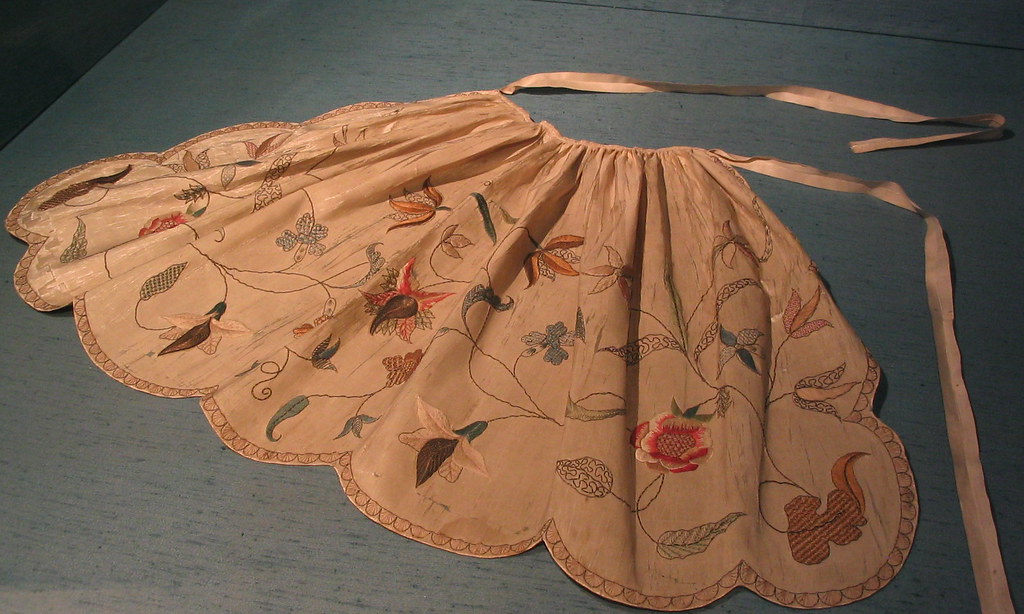
Apron worn by Lavinia Fenton in originating the role of Polly Peachum in John Gay's The Beggar's Opera, 1728: photo by Lauren, 12 January 2005

Finale scene from Robert Wilson production of The Threepenny Opera (Die Dreigoschenoper), Berlin 2008: photo by Colya Kärcher (via Susan Berenofsky: The Berlin Blog)
"Swift's first conception of it -- the pastoral method applied to Newgate"
___
"There
is a natural connection between heroic and pastoral before they are
parodied, and this gives extra force to the comic mixture. Both when in
their full form assume or preach what the parody need not laugh at, a
proper or beautiful relation between rich and poor. Hence they belong to
the same play -- they are the two stock halves of the double plot.
"Clearly
it is important for a nation with a strong class system to have an
art-form that not merely evades but breaks through it, that makes the
classes feel part of a larger unity or simply at home with each other.
This may be done in odd ways, as well by mockery as admiration. The
half-conscious purpose behind the magical ideas of heroic and pastoral
was being finely secured by the Beggar's Opera when the mob roared its
applause both against and with the applause of Walpole.
"One
of the traditional ideas at the back of the hero was that he was half
outside morality, because he must be half outside his tribe in order to
mediate between it and God, or it and Nature.... This in a queer way was
still alive in the theatre; the perversion of human feeling might not
be justified in the Restoration tragic hero, because he was so ideal,
and the Restoration comic hero was a rogue because he was an aristocrat.
The process of fixing these forms into conventions, the Tragedy of Admiration and the comedy of the predatory wit, undertaken because the former had come to seem unreal,
for some reason brought out their primitive ideas more sharply. Now on
the one hand, this half-magical view seemed to the Augustans wicked as
well as ridiculous; all men were men; they had just put down the
witch-burnings; to a rational pacifism Marlborough and Alexander were
bullies glorified by toadies. On the other hand, they were Tory poets,
and the heroic tradition, always royalist (the King's divine right made the best magical symbol),
had died on their hands. The only way to use the heroic convention was
to turn it into the mock-hero, the rogue, the man half-justified by
pastoral, and the only romance to be extracted from the Whig government
was to satirise it as the rogue. The two contradictory feelings were
satisfied by the same attitude.
"The
rogue so conceived is not merely an object of satire; he is like the
hero because he is strong enough to be independent of society (in some
sense), and can therefore be the critic of it..."
___
"I
should say then that the essential process behind the Opera was a
resolution of heroic and pastoral into a cult of independence. But the
word is capable of great shift of meaning, chiefly because nobody can be
independent altogether; Gay meant Peachum to be the villain, and there
is a case for thinking him more independent than Macheath; the animus
against him seems more than that due to a traitor; Gay dislikes him as a
successful member of the shopkeeping middle class, whereas Macheath is
either from a high class or a low one..."
William Empson: from The Beggar's Opera: Mock Pastoral as the Cult of Independence in Some Versions of Pastoral, 1935

Lavinia Fenton (1710-1760), later Duchess of Bolton, as Polly Peachum in John Gay's The Beggar's Opera: Charles Jervas (1675-1739), 18th c., oil on canvas, 127 x 102.8 cm (Christie's)

Apron worn by Lavinia Fenton in originating the role of Polly Peachum in John Gay's The Beggar's Opera, 1728: photo by Lauren, 12 January 2005
An execution outside Newgate Prison: Thomas Rowlandson, between 1805 and 1810, ink and watercolour over pencil

The Beggar's Opera: print by Thomas Rowlandson, n.d. (via Grub Street EC2)

The
infamous outlaw Jack Sheppard, thought to be the "original" of John
Gay's Captain MacHeath, pointing to the door of his cell, plotting
another daring escape: engraving by George White, based on a
painting by James Thornhill made while the subject awaited
execution in Newgate Prison, 1728; plate from Christopher Hibbert, The Road to Tyburn, 1957; image by Geogre, 4 February 2007
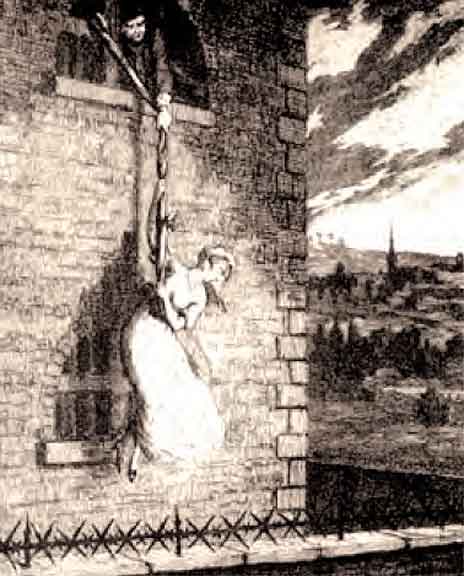
Jack Sheppard uses a rope of knotted bedclothes to lower his mistress Bess Lyon during their escape from New Prison in Clerkenwell, 25 May 1724: artist unknown
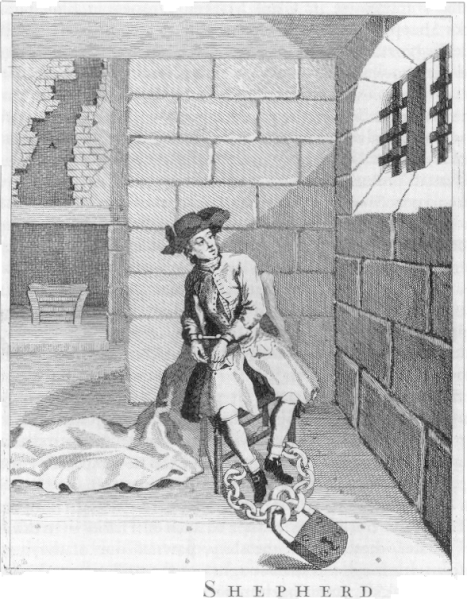
Jack Sheppard, notorious outlaw thought to have been the model for John Gay's MacHeath in The Beggar's Opera, in Newgate Prison before his fourth escape; the label "A" in the brickwork at rear marks the hole Sheppard made in the chimney during his escape: anonymous frontispiece drawing from the Narrative of Jack Sheppard's Life, published by John Applebee in 1724; image by RetiredUser2, 29 January 2007

Jack Sheppard uses a rope of knotted bedclothes to lower his mistress Bess Lyon during their escape from New Prison in Clerkenwell, 25 May 1724: artist unknown

Jack Sheppard, notorious outlaw thought to have been the model for John Gay's MacHeath in The Beggar's Opera, in Newgate Prison before his fourth escape; the label "A" in the brickwork at rear marks the hole Sheppard made in the chimney during his escape: anonymous frontispiece drawing from the Narrative of Jack Sheppard's Life, published by John Applebee in 1724; image by RetiredUser2, 29 January 2007

Wych Street, off Drury Lane, near Covent Garden, London; on this street Jack Sheppard, thought to be the original of John Gay's highwayman MacHeath, was indentured as a carpenter's apprentice in 1717: anonymous engraving, c. 1870 (Theatreleands Metropolitan Archive)

Jack Sheppard Gets Drunk: engraving by George Cruikshank (1792-1878), c. 1840 to illustrate the serialised novel Jack Sheppard by William Harrison Ainsworth, published in Bentley's Miscellany from January 1839

Jack Sheppard in the Stone Room in Newgate: anonymous engraving from Lives Of The Most Remarkable Criminals Who have been Condemned and Executed for Murder, the Highway, Housebreaking, Street Robberies, anon., n.d.

Jack Sheppard in Newgate: anonymous engraving from Jack Sheppard, Jail-Breaker in Norton, Richter: Early Eighteenth-Century Newspaper Reports: A Sourcebook

The Last Scene: engravings by George Cruikshank to illustrate the serialised novel Jack Sheppard by William Harrison Ainsworth, published in Bentley's Miscellany from January 1839; the captions read: "Jack Sheppard's Farewell to Mr Wood", "Blueskin cutting down Jack Sheppard", and "The body of Jack Sheppard carried off by the mob".
Scene from The Beggar's Opera:
print by John Doyle, b&w, 31 x 45 cm, published by Thos. McLean, 26
Haymarket, London, 15 December (Tabley House Collection Trust, University of Manchester / British Cartoon Archive, University
of Kent)
Scene from The Beggar's Opera: print by John Doyle, b&w, 31 x 45 cm, published by Thos. McLean, 26 Haymarket, London, 14 April 1841 (Tabley House Collection Trust. University of Manchester / British Cartoon Archive, University
of Kent)
Scene from The Beggar's Opera: print by John Doyle, b&w, 31 x 45 cm, published by Thos. McLean, 26 Haymarket, London, 8 April 1841 (Tabley House Collection Trust, University of Manchester / British Cartoon Archive, University of Kent)
The Beggar's Opera: print after William Hogarth (1697-1764), b & w, 58 x 45 cm, published by G. & J. Robinson, Paternoster Lane, London, 8 April 1841 (University of Manchester / British Cartoon Archive, University of Kent)

Old Bailey: drawing by Thomas Rowlandson and Augustus Pugin, aquatinting by Joseph Stadler, from Ackermann's Microcosm of London, 1808

Newgate Chapel: drawing by Thomas Rowlandson and Augutus Pugin, auatinting by J. Bluck, from Ackermann's Microcosm of London, 1808
Newgate took its name from one of the gates of the City of London. It was the jail for the most serious criminals. According to William Pyne, author of the Microcosm of London (1808), on the Sunday before the condemned were scheduled to die, the 'Ordinary' (the clergyman) of Newgate preached a special sermon in the jail's chapel. A black coffin would be placed on a table in the centre of the chapel (known as the dock). Those condemned to die sat immediately around the coffin.
The political activist, Francis Place, described his experience of visiting Newgate Prison in the mid-1790s:
"In
1794 I was several times in Newgate on visits to
persons confined for libel & c. -- one Sunday in particular I was there
when several respectable women were also there -- relatives of those I
went to see. When the time for leaving the prison arrived we came in a
body of nine or ten persons into a large yard which we had to cross --
into this yard a number of felons were admitted and they were in such a
condition that we were obliged to request the jailer to compel them to
tie up their rags so as conceal their bodies which were most indecently
exposed and was I have no doubt intentional to alarm the women and
extort money from the men. When they had made themselves somewhat decent
we came into the yard, and were pressed upon and almost hussled by the
felons whose arms and voices demanding money made a frightful noise and
alarmed the women. I who understood these matters collected all the
halfpence I could and by throwing a few at a time over the heads of the
felons set them scrambling swearing all but fighting whilst the women
and the rest made their way as quickly as possible across the yard."
(British Library, Add. MS. 27,826, Place papers. Vol.XXXVIII: Manners
and Morals, vol.II', fol.186)

The pillory at Charing Cross: hand-coloured aquatint printed by John Bluck after drawing by Thomas Rowlandson and Augustus Pugin for Ackermann's Microcosm of London, 1809

The permanent gallows at Tyburn, which stood where Marble Arch now stands. Executions at this site necessitated a three-mile cart ride in public from Newgate prison to the gallows. Huge crowds collected on the way and followed the accused to Tyburn. These were used as the gallows for London offenders from the 16th century until 1759. Note the size of this structure: about 4 metres tall, it was capable of hanging nine people at a time. The victim was led up to the gallows on a cart, put in the noose and the cart driven away, Here Jack Sheppard, aka "Gentleman Jack", notorious thief and multiple escapee, and allegedly the "original" of John Gay's Captain Macheath in The Beggar's Opera, was hanged 16 November 1724: author unknown, c. 1680 (UK National Archives)
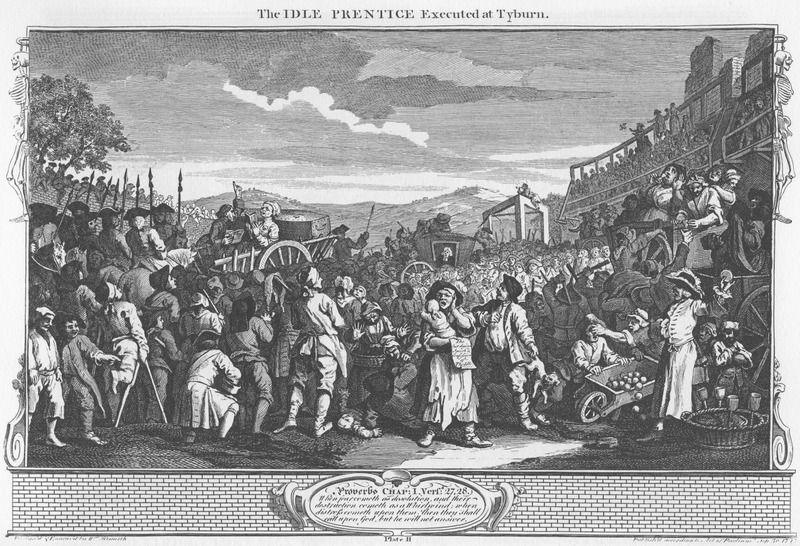
The Idle Prentice executed at Tyburn: William Hogarth (1697-1764), plate 11 in Industry and Idleness (from Hogarth's Graphical Works)
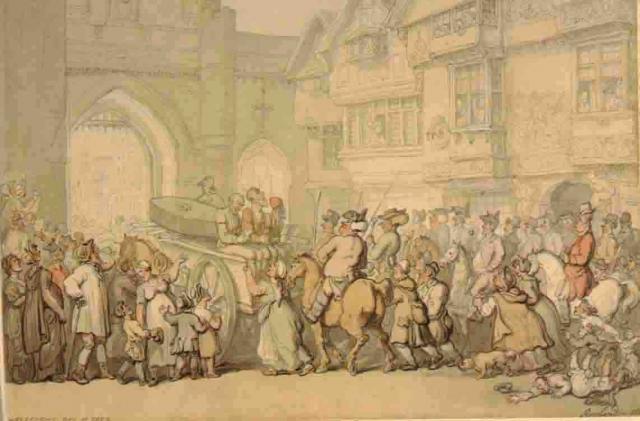
Execution Day at York: Thomas Rowlandson, c. 1820 (York Art Gallery)
The manner of execution at Tyburn: author unknown, late 17th century
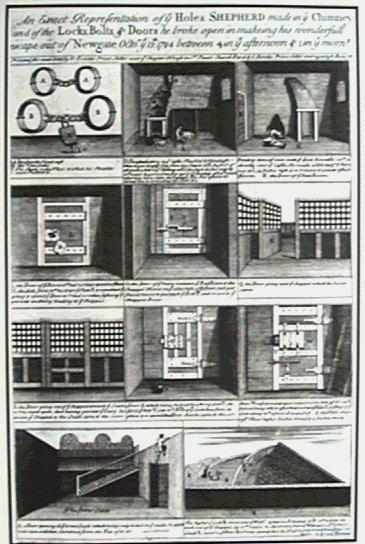


The Beggar's Opera: Air LXVII ("Since laws were made")
ReplyDeleteWe're never wholly done with class over here (for all Tony Blair's sentimental chatter): it's our great rich seam and our curse.
ReplyDeleteThe reprieve gives me great pleasure:
"All this we must do, to comply with the Taste of the Town"
Empson is spot on. The true critic must always tread delicately along the wire fence at the border.
Swift’s perspicacity and rapier wit has, in my opinion, no parallel today. He cuts to the heart of meanings and intentions that perhaps, only Plato/Socrates could reveal, meaning by meaning as to the whys and uses of the various archetypes found in theater and literature. Swift’s plumbing of art as a social and political safety net adds to the what lies behind bread and circus’s, how the status quo can be preserved, have its toxic blood let, yet entertain and for the discerning, educate and transcend amusement.
ReplyDeleteA dose of Swift is marvelous for the brain…Thank you TC.
WB,
ReplyDeleteSo glad you liked this; reading the Opera again lately, I found it quite wonderful, and was left dazzled by its genre-bending qualities, its merciless skewering of hypocrisy, avariciousnes and pomposity at all levels and in all nooks and crannies of the human "spectacle".
There is a great -- and obviously deliberate, this is the art of the thing -- blurring of borders in the Opera, as though that invisible wire fence between the classes had become tangled, so that the frontier between "high" and "low" moral and political values becomes impossibly (and hilariously) confused, and everything that is said seems to imply something else, quite often its opposite. Some of the period satire involves politics (the Whig PM, Walpole, paired with a comparable arch-manipulator, Peachum) and style (the rage in London for Handelian operatics, which the play exposes), but these references appear now to comprise the furniture of the piece, topical bits of joke overlaid upon its underlying structure.
Parallels between the opposed social classes are often presented in ways that would have seemed sharp, even embarrassing to some at the time. This shock effect along with the exuberant fun of the thing combined to make the play so successful that Handel was driven off the London stage for a whole season by Gay's triumph.
All these centuries later however the thrust and point of the play remain unblunted. To show that roguery reigns equally on both sides of the social no man's land, with the most powerful rogues on either side enjoying their successes at the expense of everybody else -- and only those of the "low" side ever getting caught out, due to something (something, we are shown, about human nature) built permanently into this terrible equation -- this achievement of Gay's seems at least as pertinent in 2012 as it would have in 1728.
The Beggar's Opera was the first of the ballad operas to hold the stage beyond the end of the eighteenth century, and in the nineteenth it developed into musical comedy. Some at the time thought Gay had got the idea from Addison's curious production Rosamund (1707). But Bonamy Dobrée, who was a close scholar of the period, wrote in 1959 as follows:
"...'Whether this new drama [of Gay's] was the product of judgement or of luck' as Dr Johnson was to comment, 'the praise of it must be given to its inventor'. And it had in it, as recent revivals suggest, the elements of permanence, because although human value are reversed, they exist by implication, and serve as a basis for the apparently careless grace and wit of the whole enchanting and virile performance. How far play-goers can be aware of what Gay is actually doing with them is doubtful: the 'double-irony' method, out of which the jokes are constructed, is inherent in the whole movement of the story', as Professor Empson analyses it in his brilliant study, and the method takes a little time to penetrate; the actors seem to say one thing while actually implying its contrary; delightful shocks are administered to moral sensibility; Macheath can come out with such a Senecan 'sentence' as
A moment of time may make us unhappy for ever;
and the underlying grimness itself stimulates the gaiety, which is sometimes of a weighty order. It is a serious criticism of society delivered as a light-hearted jest."
Artemisia,
ReplyDeleteSorry to have missed yours till I'd replied to the previous. But yes, Swift is certainly relevant here. It's thought he planted the idea for the Opera in Gay's mind; that would make sense; and in the end there came a brilliant harvest.
These days there is little taste for writers with these rapier skills; indeed, these days, the exercise of such skills would surely prove career-threatening; and skills that are not used can never have been developed; which is unfortunate, for we live in a society that at times seems to beg to be addressed not with kid-gloves fondness but upon the tines of a barbecue fork.
By the by, it's long seemed to me that a small bit of characteristically disarming self-memorializing Gay left behind to be remembered by might well serve equally for many a much less gifted writer:
ReplyDeleteMy own Epitaph
Life is a jest; and all things show it,
I thought so once; but now I know it.
RHETORICAL QUESTION
ReplyDeleteRapier skills as in rapier wit?
Alas, no point in asking
If parried by dullard,
Fencesitting dimwits.
Teachers are beggars in the Opera
ReplyDeleteoften the only ones in town
with jobs
from the state
theater of middle management
too much time
too much blood
on hands
wringing out
the results
from the newest
newly-laundered
exam
instead of strangling
little necks
as would seem proper
given this ongoing
paradox.
Sing it out, teachers
make the song loud
make it endless.
Venn Diagram: Kafka vs. Hitler
ReplyDeleteIn the middle
Is the need for shelter
From the surreal body
One moves outside the circle
Against the rules
One moves closer
To the middle
Of his circle the edge
Too mossy and fertile
Human humiliating
One keeps disappearing
Like he was not there
Anonymous
They both wanted
The mundane to be left alone
At the end. To do whatever.
We cannot stop thinking about them
About their fears
One was Ferdinand the Bull
One pretended to be
One dreamed of moss
One of modern convenience
Of which he was used
Mundane chores
Both were already in the future
About the paradox—
One left the diagram
Completely
Forced into
The number line
O teacher, o little lamb teacher
ReplyDeletepublic school teacher
fluffed up for the slaughter
for the sacrifice
of the test
that everyone cheats on--
are you now in your
little bunker
waiting for the end?
I see the mini-fridge
you desired
thought of in your widowhood
and the plug-in kettle
for java
who could not do without
these modern conveniences
in a modern classroom
as you wait
for the final bell
like a comfortable mummy
all wrapped up
in a cozy cardigan
despite the heat
reading about your husband
Mr. Franz Kafka.